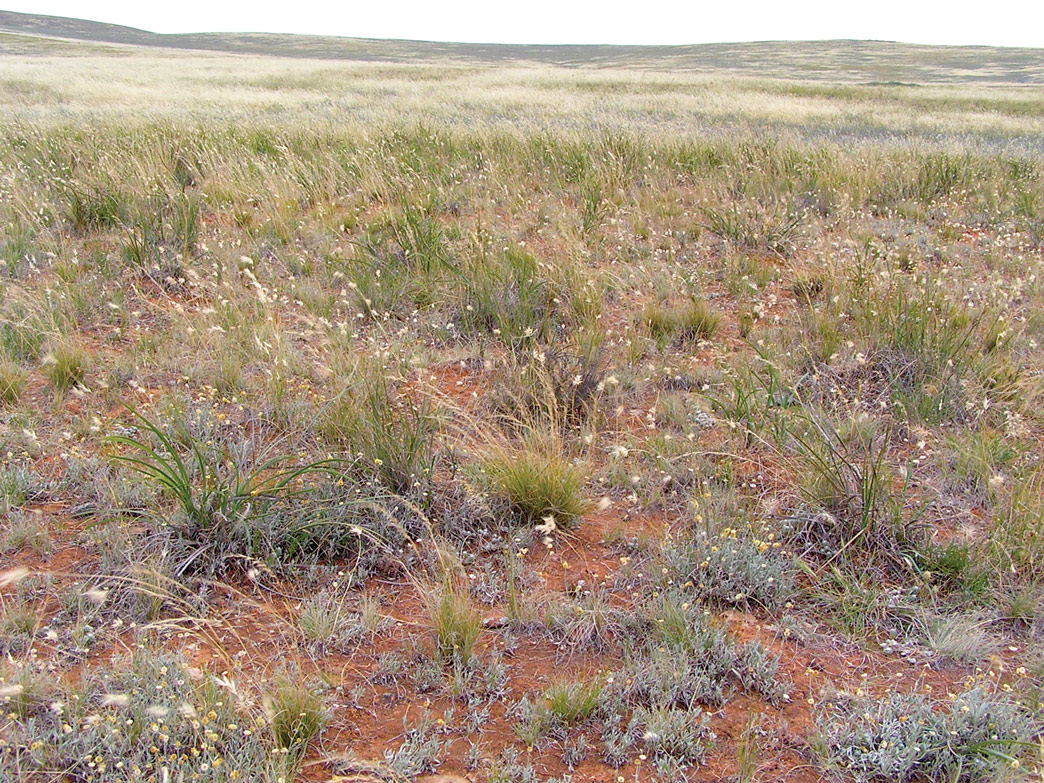
Iron-grass Natural Temperate Grassland of South Australia, occurs on gentle slopes of low hills, and in broad valleys with elevations from 50 m to more than 500 m, with the largest areas in the Lower North, Mid North and Upper North districts above 300 m. Iron-grass grasslands are different to the other grasslands of south-eastern Australia because they are often dominated, not by grasses, but by Lomandra species, known in South Australia as Iron-grasses. These are tussock-forming plants from the lily family (Liliaceae) that are present in other grasslands but not dominant. Closer to Adelaide, historical records suggest that the original grasslands were more dominated by Themeda triandra, but with similar mix of other species, including subdominant Lomandra species. Only isolated patches of these grasslands remain today.
Lomandra multiflora subsp. dura (Many-flowered Mat-rush) tends to be more common in richer soils and higher rainfall areas and Lomandra effusa (Scented Mat-rush) tends to be more common in poorer and stonier soils with lower rainfall. Other Lomandra species, such as L. micrantha (Small-flowered Mat-rush) and L. densiflora, are also characteristic. A wide range of native tussock grasses occur with the Lomandra species and may be co-dominant or dominant, particularly on deeper valley soils, but these areas have been almost entirely lost to agriculture. Common native grasses in these communities are Rytidosperma (Wallaby Grasses) and Austrostipa species (Spear Grasses). Other important grass species are Aristida behriana (Bush Wire-grass), and Themeda triandra (Kangaroo Grass). The shrub Bursaria spinosa (Sweet Bursaria) occurs sporadically in most grasslands, along with occasional patches of Acacia pycnantha (Australian Golden Wattle) and Allocasuarina verticillata (Drooping She-oak) which are usually found on stony rises. Many of the most frequently occurring native herbs in Iron-grass Natural Temperate Grasslands are common to other grassland communities in south-eastern Australia. These include Wahlenbergia luteola, Goodenia pusilliflora (Small-flower Goodenia), G. pinnatifida (Cut-leaf Goodenia), Convolvulus erubescens (Blushing Bindweed), Vittadinia gracilis (Woolly New Holland Daisy), Chrysocephalum apiculatum (Common Everlasting), Ptilotus spathulatus (Cat’s Paw) and Leptorhynchos squamatus (Scaly Buttons). Chenopod species such as Maireana enchylaenoides (Wingless Bluebush), Maireana excavata (Bottle Bluebush), Enchylaena tomentosa (Barrier Saltbush) and species more typical of arid areas are also common, especially in drier areas. A variety of native daisies are often the most diverse and prolific herbaceous species present.
Aristida behriana, Rytidosperma auriculata, Rytidosperma caespitosa, Rytidosperma carphioides, Austrostipa acrociliata, Austrostipa blackii, Austrostipa elegantissima, Austrostipa eremophila, Austrostipa nitida, Austrostipa scabra, Enneapogon nigricans, Astrostipa nodosa, Themeda triandra, Bulbine bulbosa, Dianella revoluta, Anthropodium strictum, Lepidosperma viscidum, Lomandra effusa, Lomandra multiflora subsp. dura, Wurmbea dioica subsp.dioica, Asperula conferta, Brachyscome lineariloba, Calocephalus citreus, Chrysocephalum apiculatum, Chrysocephalum semipapposum, Convolvulus erubescens, Convolvulus remotus, Crassula colorata, Crassula sieberiana subsp. tetramera, Eryngium ovinum, Euphorbia drummondii, Glycine clandestina, Goodenia pinnatifida, Goodenia pusilliflora, Hyalosperma semisterile, Isoetopsis graminifolia, Leptorhynchos squamatus, Leptorhynchos tetrachaetus, Minuria leptophylla, Oxalis perennans, Plantago varia, Podolepis tepperi, Ptilotus spathulatus, Rhodanthe pygmaea, Rumex dumosus, Euphorbia drummondii, Goodenia pinnatifida, Goodenia pusilliflora, Hyalosperma semisterile, Isoetopsis graminifolia, Leptorhynchos squamatus, Leptorhynchos tetrachaetus, Minuria leptophylla, Oxalis perennans, Plantago varia, Podolepis tepperi, Ptilotus spathulatus, Rhodanthe pygmaea, Sida corrugata, Stackhousia monogyna, Swainsona behriana, Thysanotus baueri, Velleia arguta, Velleia paradoxa, Vittadinia cuneata, Vittadinia gracilis, Vittadinia megacephala, Wahlenbergia luteola, Bursaria spinosa, Cryptandra amara, Enchylaena tomentosa, Maireana enchylaenoides, Maireana excavata, Pimelea micrantha
Western Grey Kangaroo, Red Kangaroo, Euro, Short-beaked Echidna, Gould’s Wattled Bat, Chocolate Wattled Bat, Southern Freetail-Bats, White-Striped Freetail-Bat, Plains-wanderer, Australian Bustard, Galah, Emu, Australasian Pipit, Brown Songlark, Masked Lapwing, Little Raven, Wedge-tailed Eagle, Australian Magpie, Crested Pigeon, Common Bronzewing, Stubble Quail, Little Button-Quail, Flinders Ranges Worm-lizard, Eastern Bluetongue Lizard, Pygmy Blue-tongue Lizard, Bougainville’s Skink, Dwarf Skink, Grass Skink, Sleepy Lizard, Central Bearded Dragon, Eastern Brown Snake, Wolf Spider, Trapdoor Spider, White-spot Skipper, Painted Lady, Meadow Argus, Common Grass-Blue.